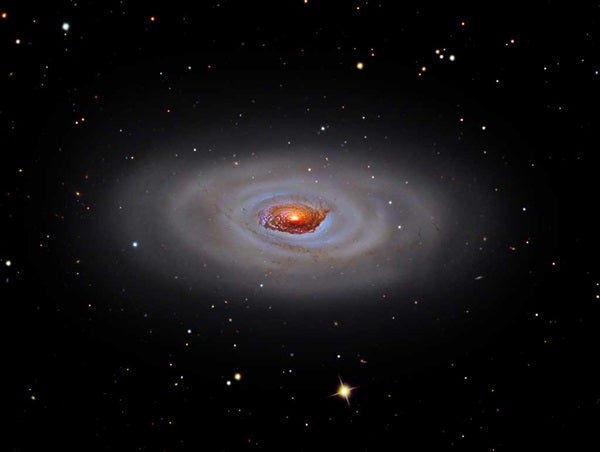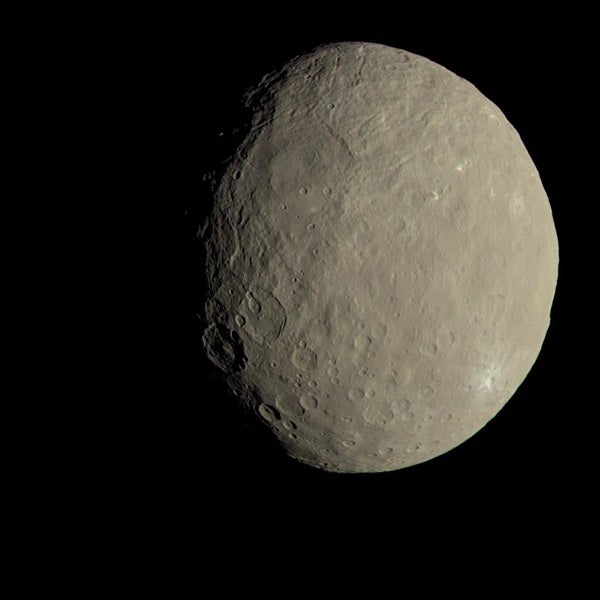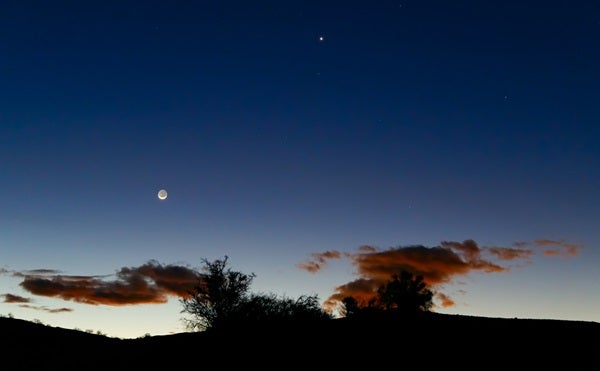Head outside late this evening and you can’t miss Jupiter. The giant planet rises before 10 p.m. local daylight time and climbs highest in the south around 2 a.m. Jupiter shines at magnitude –2.6, which makes it the brightest point of light in the sky until Venus rises in morning twilight. The planet currently resides among the much dimmer background stars of the constellation Ophiuchus the Serpent-bearer. A telescope reveals dramatic cloud features on the gas giant’s 46″-diameter disk as well as the four bright Galilean moons. And tonight provides a rare opportunity to see the solar system’s largest satellite disappear. As Jupiter rises, Ganymede appears west of the planet. If you keep watching, however, you’ll see the moon slowly fade from view. At 1:41 a.m. EDT, Ganymede starts to enter Jupiter’s shadow while it is still 16″ from the planet’s limb. The moon is so big that it takes 14 minutes to disappear completely.
Saturday, May 25
Binoculars open a world of wonders invisible to the naked eye. Did you realize you could see several galaxies without resorting to a telescope? One of the spring sky’s best is the Blackeye Galaxy (M64) in Coma Berenices. This constellation stands high in the south once darkness falls. The 8th-magnitude spiral galaxy appears about 1° northeast of the 5th-magnitude star 35 Comae Berenices. M64 is barely in range of 50mm binoculars under a dark sky, although you’ll need 80mm or larger binocs or a telescope to spot the dark dust lane that gives the galaxy its “black eye.”
Sunday, May 26
Last Quarter Moon occurs at 12:34 p.m. EDT. When it rises around 2:30 a.m. local daylight time tomorrow morning, it will appear slightly less than half-lit. Earth’s only natural satellite then appears against the background stars of Aquarius the Water-bearer.
Today also marks the Moon’s apogee, the farthest point in its orbit around Earth. At 9:27 a.m. EDT, it lies 251,119 miles (404,138 kilometers) from Earth’s center.
Monday, May 27
For the first time this year, you can glimpse Saturn in the evening sky. The ringed planet rises around 11:30 p.m. local daylight time this week and climbs highest in the south as morning twilight starts to break. Saturn shines at magnitude 0.3 and appears significantly brighter than any of the background stars in its host constellation, Sagittarius the Archer. A telescope reveals the planet’s 18″-diameter disk and a stunning ring system that spans 41″ and tilts 24° to our line of sight.
The dwarf planet Ceres reaches opposition and peak visibility today. The largest member of the asteroid belt between the orbits of Mars and Jupiter, Ceres lies on the border between Scorpius and Ophiuchus. This region appears 20° above the southeastern horizon at the end of evening twilight and more than 30° high in the south around 1 a.m. local daylight time. You’ll need binoculars or a telescope to spy its 7th-magnitude glow. Use magnitude 4.3 Chi (χ) Ophiuchi as a guide. Tonight, Ceres lies 1.2° northwest of this star.
Wednesday, May 29
You can use the Big Dipper as a guide to two of the spring sky’s brightest stars. If you follow the curve of the Dipper’s handle to the south, you’ll easily spot Arcturus. This magnitude 0.0 star, which belongs to Boötes the Herdsman, lies some 30° from the end of the Big Dipper’s handle. It is the fourth-brightest star in the whole sky and the second-brightest visible from mid-northern latitudes. And if you continue the curve another 30° past Arcturus, you’ll arrive at magnitude 1.0 Spica, the luminary of Virgo the Maiden. An easy way to remember the two is with the phrase: “Follow the arc to Arcturus, then drive a spike to Spica.”
Thursday, May 30
Neptune rises around 2 a.m. local daylight time and appears 15° high in the east-southeast as twilight commences. The distant world glows at magnitude 7.9, so you’ll need binoculars or a telescope to spot it. Fortunately, it lies near a brighter star that will guide you. This morning, Neptune stands 1.2° east-northeast of 4th-magnitude Phi (φ) Aquarii. You can confirm your sighting of Neptune through a telescope, which reveals the planet’s 2.3″-diameter disk and blue-gray color.
Friday, May 31
Mars continues its eastward trek against the backdrop of Gemini this week. Shining at magnitude 1.8, the Red Planet appears slightly fainter than the constellation’s brightest stars, Castor and Pollux. But it appears noticeably brighter than Epsilon (ε) Geminorum, the 3rd-magnitude star it passes 1° south of this evening. Mars lies nearly 15° high in the west-northwest an hour after sundown and doesn’t set until 10:30 p.m. local daylight time. If you turn a telescope on the planet, you’ll see a featureless disk that spans only 4″.
Venus pokes above the eastern horizon about an hour before sunrise. The brilliant planet dominates the predawn sky as the rosy glow heralding the Sun’s arrival grows brighter. Venus shines at magnitude –3.8, three times brighter than the second-brightest planet, Jupiter. The inner planet looks stunning all week, but never more so than it does this morning when a waning crescent Moon lies to its right. The two stand about 6° apart and a similar distance above the horizon a half-hour before sunrise. If you view Venus through a telescope, you’ll see a disk that spans 10.5″ and appears 94 percent lit.
Sunday, June 2
You can use Mars as a guide to finding Mercury. With binoculars in hand, scan to Mars’ lower right starting about 30 minutes after sunset. Mercury shows up as a bright dot some 7° high in the west-northwest. It shines at magnitude –1.0 and appears obvious to the naked eye once you know where to look. A telescope reveals the innermost planet’s 6″-diameter disk, which appears 85 percent lit.












